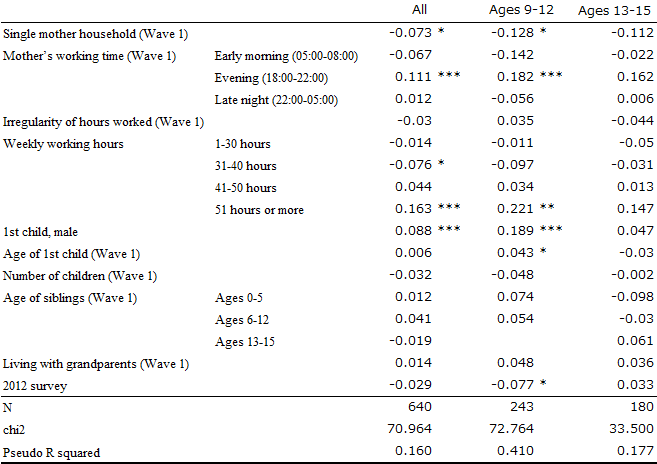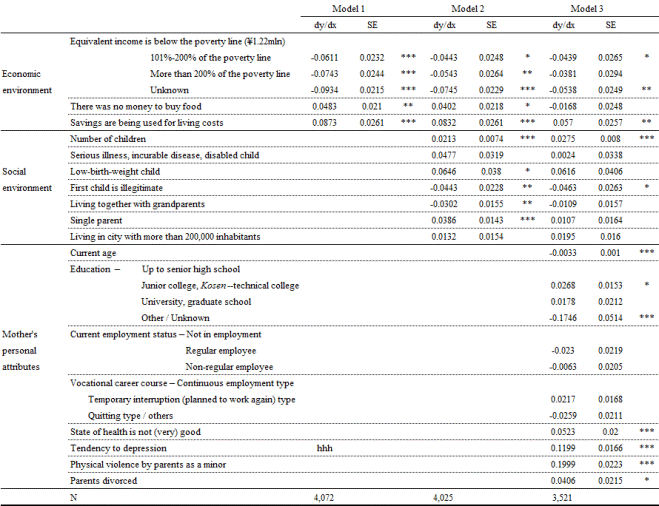JILPT Research Report No.189
Distress in Childrearing Households
March 27, 2017
Summary
Research Objective
With a serious decline in the birth rate, there is growing public concern over issues of childrearing. Social support for childrearing households is increasingly strengthened through almost fully subsidized childbirth costs, free medical treatment for small children, and an enhanced system of childcare leave, and so on. However, positive comments that childrearing today is “easier” or “less demanding” than it used to be are hardly ever heard from mothers. If anything, social issues connected with childrearing are now emerging more frequently than before, in forms such as child poverty, child abuse, children eating alone at home, or the “juggling act” for women who balance employment with housework and childrearing.
Over five years from 2011 to 2015, JILPT conducted a series of questionnaire surveys on childrearing households throughout Japan as part of its “Studies on Childrearing Women’s Employment” Project Research. This Report clarifies various forms of distress affecting childrearing households in Japan, based on the results of these surveys. Particular focus is on distress caused by a lack of income and leisure time in childrearing households, distress related to continued employment by the mother, and childrearing distress. After presenting the respective situations and issues in each of these areas, measures to support for childrearing households will be considered.
This Report is divided into three parts. Part 1 (Chapters 1) presents the findings on economic distress in childrearing households. Part 2 (Chapters 2 to 4) focuses on employment distress among mothers. Finally, Part 3 (Chapters 5 and 6) analyzes work-life and childrearing distress among mothers.
Research Method
Intensive analysis of microdata from the following questionnaire surveys.
- “2011 survey on living standards of households with children and the employment status of their parents” (“The First National Survey of Households with Children 2011”) *For details, see Research Series No.95 (2012).
- “2012 survey on living standards of households with children and the employment status of their parents” (“The Second National Survey of Households with Children 2012”) *Research Series No.109 (2013)
- “2014 survey on living standards of households with children and the employment status of their parents” (“The Third National Survey of Households with Children 2014”) *Research Series No.145 (2015)
- “Follow-up survey on childrearing households (1st: 2013)” *Research Series No.115 (2014)
- “Follow-up survey on childrearing households (2nd: 2015)” *Research Series No.159 (2016)
Main Findings
In Chapter 1, Aya Abe focuses on economic distress. Abe’s paper highlights a negative spiral whereby financial hardship leads to divorce, which in turn causes further financial hardship. Although the correlation between poverty and divorce is only confirmed in analysis of cross-sectional data, this study warns that the lack of financial security could lead to family collapse in childrearing households.
Chapters 1 reflects the conflict that arises when childrearing households seek both financial and time-related affluence. With so few full-time housewives now able to enjoy affluent lifestyles, many childrearing households are forced into a tough choice between having a surfeit of time or a surfeit of money. There is no shortage of full-time housewives who prefer to spend time on childcare and housework, and are therefore living on the breadline.
As women’s employment during the childrearing phase becomes the norm, the papers by Tomoe Naito (Chapter 2), James Raymo (Chapter 3) and Naofumi Sakaguchi (Chapter 4) analyze distress arising from women’s employment. Of these, Naito indicates that women who continue to work before and after pregnancy and childbirth are very likely to have mothers (grandmothers of their children) who also worked during the childrearing phase. Raymo finds that women’s employment is being pushed upwards not only by “living with the children’s grandparents” but also by “living close to the grandparents.” Sakaguchi suggests that pre- and post-childbirth employment paths of women with strong educational backgrounds and women who have specialist qualifications tend to be classified in the “working mother group.”
In all three of these papers (Chapters 2 to 4), the research focuses on the difficulty women have in continuing to work before and after pregnancy and childbirth, and searches for clues to remedy this. To summarize their conclusions in brief, providing more nurseries and enhancing childcare support systems are not enough for women to keep working. Traditional employment practices that have been passed down since their grandmothers’ generation, the existence or lack of assistance from grandparents in housework and childcare, and the human capital vested in the women themselves (education, qualifications, etc.) will also be important factors in continued employment by women.
As women’s employment grows and the income environment of childrearing households becomes increasingly harsh, Akiko Oishi (Chapter 5) and Yanfei Zhou (Chapter 6) analyze the various problems that affect children, and the causes of those problems. Of these, Oishi focuses on the impact of night work by mothers on their children’s school grades. Although a negative impact is confirmed in analysis of cross-sectional data (Table 1), this impact turns out to be insignificant in panel data estimation at three points in time. Zhou sheds light upon the problem of child abuse, for which cases of consultation have been increasing sharply in recent years. Zhou shows that, besides pathological factors such as the mother’s tendency toward depression, poverty and other aspects of the economic environment are also significantly involved with child abuse. (Table 2).
Table 1. Child’s Academic Performance Estimated Using a Logit Model with Wave-1 Lag

- Note: 1. Figures are marginal effects. To adjust the over-sampling of single-parent households, weighted estimations are reported. *p<0.1, **p<0.05, ***p<0.01
- 2. Besides the above, explanatory variables also include mother’s age, mother’s education, grandfather’s education, household income (quartile), savings, experience of material deprivation, number of mother’s unhappy life events, and child’s own previous experience of non-attendance at school.
Table 2. Experience of “child abuse” (CM1, CM2 or CM3) Estimated Using a Probit Model

- Notes: 1. To adjust the over-sampling of single-parent households, weighted estimations are reported.
- 2. *p<0.1, **p<0.05, ***p<0.01
The research in both of these papers (Chapters 5 and 6) focuses on childrearing distress in an “era of uncertainty.” Overseas empirical research indicates that employment of mothers in atypical working hours has a negative impact on their children’s educational performance as the “24/7 economy” (production activity 24 hours a day, seven days a week) expands. Although some improvement is needed in the analyzed data and performance indicators, Chapter 5 reaches a slightly different conclusion from this overseas research. On the other hand, the analysis results in Chapter 6 are consistent with research in other countries linking child abuse not only to pathological factors (in the mother) but also to factors in economic and social environments. This analysis confirms that changes in environmental factors, i.e. a decrease in real gross income and a rise in poverty ratios of childrearing households, carry risks that lead to an increase in child abuse.
Policy Implications
The analysis in this Report has flagged up a number of potential approaches to eliminating distress in childrearing households. First, the most important challenge is to relieve economic distress in low-income households by strengthening livelihood recovery support while reducing tax and social security burdens on childrearing households. Specific measures for livelihood recovery support could include developing the “earning capacity” of childrearing households through high-quality vocational training, recurrent education after graduation from school, or enhanced intern systems for housewives seeking a return to employment. Second, an urgent task is to reduce employment distress and childrearing distress of mothers. Specifically, more should be done to remove factors that prevent childrearing parents from “living together with” or “living close to” grandparents, provide information and work-life balance lectures to stop the conventional practice of interrupting careers in the childrearing phase, and provide educational support activities for children after school hours, among other efforts. Finally, it is essential that we reform gender-specific working styles. If we could change the situation that men work in the primary labor market regardless of family commitments while all housework and childcare are assigned to women, and women work part-time for low wages in the secondary labor market, we would be on the way to reducing distress in childrearing households.
Policy Contribution
The results of this research are expected to be used as basic data for women’s labor force participation and childcare support.
Contents (available only in Japanese)
- JILPT Research Report No.189 / Whole text (PDF:1.7MB)
If it takes too long to download the whole text, please access each file separately.
- Cover – Preface – Authors – Contents (PDF:698KB)
- Introduction: Distress in childrearing households – Research objective, method and main content (PDF:662KB)
- Chapter 1: Trial analysis on the connection between divorce and poverty and the impact of divorce on children (PDF:920KB)
- Chapter 2: Generational chain of mothers’ working (PDF:1.0MB)
- Chapter 3: Support from grandparents and mothers’ vocational careers – Focusing on three generations living together or near each other (PDF:972KB)
- Chapter 4: Women’s life path and desirable support for women (PDF:958KB)
- Chapter 5: Realities of mothers’ employment in atypical working hours and how it impacts their children (PDF:1.0MB)
- Chapter 6: Child abuse by mothers – Mothers’ self-recognition and environmental factors (PDF:971KB)
Research Category
Project Research: “Research on Improving the Quality of Employment and Realizing Decent Work by Innovating Companies’ Employment Systems, Personnel Strategies and Work Rules, etc.”
Subtopic: “Research project on promoting women’s participation”
Research Period
FY2016
Authors
- Yanfei ZHOU
- Senior Researcher, JILPT
- Aya ABE
- Professor, Faculty of Urban Liberal Arts, Tokyo Metropolitan University
- Tomoe NAITO
- Temporary Research Assistant, JILPT
- James RAYMO
- Professor, Department of Sociology, University of Wisconsin-Madison
- Naofumi SAKAGUCHI
- Associate Research Fellow, the Institute for Research on Household Economics
- Akiko OISHI
- Professor, Faculty of Law, Politics and Economics, Chiba University
Catergory
Workers' life / Workers' awareness
Related Research Results
- Research Series No.159, “Follow-up Survey on Childrearing Households (Second Survey: 2015): Tracing Lifestyle Changes over Four Years,” (2016)
- Research Series No.145, “Survey on Living Standards of Households with Children and the Employment Status of Their Parents 2014 (3rd National Survey of Households with Children),” (2015)
- Research Series No.115, “Follow-up Survey on Childrearing Households (First Survey: 2013): Comparison with the 2011 and 2012 Surveys,” (2014)
- Research Series No.109, “Survey on Living Standards of Households with Children and the Employment Status of Their Parents 2012 (2nd National Survey of Households with Children),” (2013)
- Research Series No.95, “Survey on Living Standards of Households with Children and the Employment Status of Their Parents,” (2012)
- “Useful Labor Statistics 2016: Aggregation of processed indicators for labor statistics 2016”: 297.
JILPT Research Report at a Glance
| To view PDF files, you will need Adobe Acrobat Reader Software installed on your computer.The Adobe Acrobat Reader can be downloaded from this banner. |

